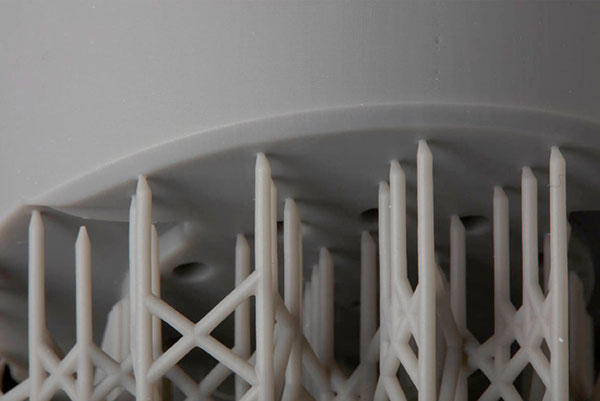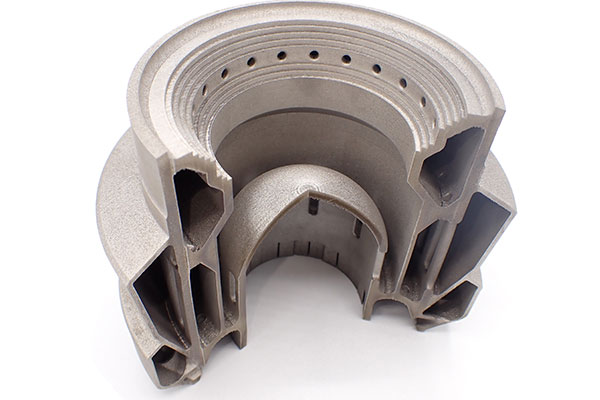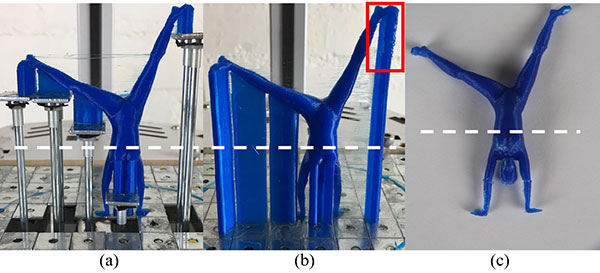The Support-Free 3D Printing Balancing Act
Despite the upside to support-free 3D printing, supports should be considered as just another tool in the toolbox to optimize certain parts and applications.

“Light Touch” supports, offered for a range of Formlabs materials, make it easier to break off and remove supports. Image courtesy of Formlabs.
Latest News
March 28, 2023
Regarding the reality of support-free 3D printing, there’s a long-standing joke: The best support strategy, the anecdote posits, is no supports—that is, until the best strategy actually calls for supports to ensure the optimal output.
That circular logic is very much still alive today. Despite a range of new technologies and best practices aimed at eliminating or reducing the need for support structures in additive manufacturing (AM), an ongoing debate remains over whether true support-free 3D printing is a reasonable design goal or simply an option for certain parts and manufacturing scenarios.
Conventional wisdom favors the latter. 3D printing experts say support-free AM shouldn’t be viewed as a panacea, but rather as another design goal predicated on a range of parameters, from the specifications and design requirements of a part to the type of AM process most suitable for efficient and cost-effective production.
It’s all about evaluating trade-offs, experts say, as part of the broader design for manufacturing (DfM) and design for AM (DfAM) strategies that factor in intelligent build orientation and post-processing requirements, says Jeph Ruppert, director of the application innovation group at 3D Systems.
“You have to look at productivity and the performance improvements enabled by design,” Ruppert says, explaining that much can be accomplished by reducing the number of supports. “[Support-free 3D printing] can open up the design space and improve performance, but there are other ways to address those goals. It’s just another tool in the toolbox.”
Pros and Cons of Support-Free 3D Printing

Without question, supports have a key role to play. They prevent deformation associated with thermal stresses, facilitate heat transfer and protect a part as it forms from possible recoater blade disruption. Strategically placed, supports also keep parts steady on the build plate during the print process. A general rule is that supports are required for parts that have features extending under 45 degrees from the build platform.
Yet as AM gains traction for production and prototyping applications, engineering organizations have been chasing the idea of support-free 3D printing for various reasons. Printing without supports, regardless of the AM technology, has plenty of upsides, including less material use, which can lessen overall printing costs and lead to faster print times. Support-free 3D printing also reduces material waste and energy usage, which improves 3D printing’s environmental impact.
There are additional considerations. Printing without supports minimizes or eliminates post-processing requirements. This streamlines print cycles and decreases expenses as there is no additional sanding, polishing or solutioning stations required to clean up support remnants and get a part ready for end use. Printing sans supports also means there is no need for additional manpower to tend to the finishing work, which then drives more efficient production cycles. Some designs require supports that can’t be removed easily or at all, which, while not impeding part function, adds weight that could degrade overall performance.
On the flip side, eliminating supports for 3D printing jobs has its downsides. For one, design and production of more complex geometries is limited as you lose the ability to output fine details as well as larger print sizes that would typically require auxiliary structures.
With certain AM technologies such as metal 3D printing, supports not only hold up overhanging features and prevent distortion—they also play a role in absorbing and distributing excess heat away from the parts during the print process.
“Eliminating supports is a reasonable goal for most AM technologies, but supports don’t always have the same function,” says Nicolas Mathian, head of marketing at Sculpteo. “The fact is, use of supports depends on the geometry and some will require supports as a criteria for a successful print. You can redesign a part to do without supports, but depending on the part, that’s not always possible.”
In scenarios where there is a relatively simple part with easy access for someone to do the required post-machining and post-processing work, it’s generally considered a best practice to stick with a standard support strategy.
“Why get cute and try to build something without supports if supports remain the most efficient way to manage thermal issues or structural integrity?” 3D Systems’ Ruppert says.
For instance, in metal 3D printing, it becomes harder to achieve thin walls and high feature fidelity of the final part without supports. “Instead, choosing a different orientation or doing fillets can be more meaningful [than eliminating supports] to achieve the desired design improvements,” he says.
Some AM technologies—selective laser sintering (SLS), for example—have inherent characteristics that eliminate the need for supports altogether. SLS 3D printing employs a high-power laser to sinter small particles of polymer powder into a solid structure, leaving the unfused powder to support the part during the print process and eliminating the need for dedicated support structures.
Changing the Support Equation
Outside of the debate, 3D printer makers, researchers and manufacturing service providers are taking real steps to minimize the need for supports if not eradicate them completely.
Development work is being done at the University of Southern California (USC) Viterbi’s School of Engineering. A research team in the Daniel J. Epstein Department of Industrial and Systems Engineering has created a low-cost reusable support method to reduce the need for supports, with the goal of minimizing material and energy waste to improve cost-effectiveness and sustainability of 3D printing. They claim early prototypes of the system resulted in a 35% reduction of materials used to print objects.

An example of reusable supports developed by a USC research team. Image courtesy of Professor Young Chen, USC Viterbi’s Daniel J. Epstein Department of Industrial and Systems Engineering.
Instead of traditional layer-by-layer printing onto a static metal surface, the prototype employs a programmable, dynamically-controlled surface comprised of moveable metal pins that rise and fall during the print process to replace traditional printed supports. Software would instruct users where to add and position the tubes that hold the pins serving as supports, allowing them to be reused for future print applications, according to Yong Chen, professor of industrial and systems engineering, who leads the research team.
“We are trying to converge supports into some type of recyclable structure that can be reused,” Chen says. “Our motivation is to reduce waste and shorten the printing time.”
Chen’s research team has applied for a patent on the technology and is talking to the 3D printing community about the possibilities of commercializing the moveable build platform for a variety of 3D printers.
In the near term, 3D printer manufacturers are also pushing boundaries to reduce the need for supports in the AM process. Formlabs, for example, has been expanding its “Light Touch” supports to additional materials in its library to improve the user experience with printing and removing supports, says Evan Fisher, the company’s 3D model manager.
The light touch support function, enabled on all Form 3 Plus printers and enabled by its Preform slicing software, enables users to remove the entire print from the build platform at once, helping to reduce surface wear and damage from the support removal process. The Preform software also leverages a color gradient scale to help users visualize what’s happening in the 3D printing process so they can optimize where and how supports are used, Fisher says.
“Without going back into CAD, that can be a real guessing game for engineers. Preform helps engineers quickly see if they need to reorient the model or change the geometry at a glance” as part of a process designed to minimize support usage, he says.
Many 3D printer manufacturers are addressing the support-free 3D printing challenge not through product features, but by offering relevant consulting services or packaging up best practices and building templates to help advance the cause.
EOS has put a significant amount of time and energy into creating process optimization techniques for building various parts without the need for supports, including hip stems and shrouded impellers, which are used in myriad applications. For the latter use case, an EOS Additive Minds Consulting team optimized the direct metal laser sintering (DMLS) process and an optimized part design to create a closed impeller in a flat orientation with no internal supports, even with part feature overhangs of 10 to 15 degrees. The Additive Minds team is using the findings from the impeller application to develop future parameters using other materials to improve low angle buildability, increasing the number of support-free 3D printing scenarios.
“It’s very difficult or completely impossible to remove support structures and not every use case is a candidate, but we’re trying to open the application possibilities,” says Davy Orye, team manager at Additive Minds Consulting, a part of EOS GmbH.
3D Systems has also built up substantial intellectual capital as part of its NoSupports metal printing methodologies, which target enclosed structure areas where support removal is difficult or impossible.
The NoSupports strategies, implemented through Oqton’s 3DXpert AM software, help users reduce supports through implementation of DfAM principles; deploying a thermal blade as a heat sink to dissipate heat away from part features, making them easier to remove and requiring fewer finishing steps; and multi-exposure printing, when a single powder deposition is scanned twice, allowing for greater control over how energy is applied thus resulting in higher quality outcomes.
Protolabs has seen an uptick in demand for support-free 3D printing and is continuously honing its processes and capabilities to deliver—when and where it makes sense. “I don’t think you can exhaust design until there are zero supports left as you’ll have diminishing returns,” says Eric Utley, the company’s 3D printing applications engineer. “If you eliminate 80 percent of supports, you’re doing pretty well.”
More 3D Systems Coverage
More EOS Coverage
More Formlabs Coverage
More Protolabs Coverage
More Sculpteo Coverage
Subscribe to our FREE magazine, FREE email newsletters or both!
Latest News
About the Author
Beth Stackpole is a contributing editor to Digital Engineering. Send e-mail about this article to DE-Editors@digitaleng.news.
Follow DE





